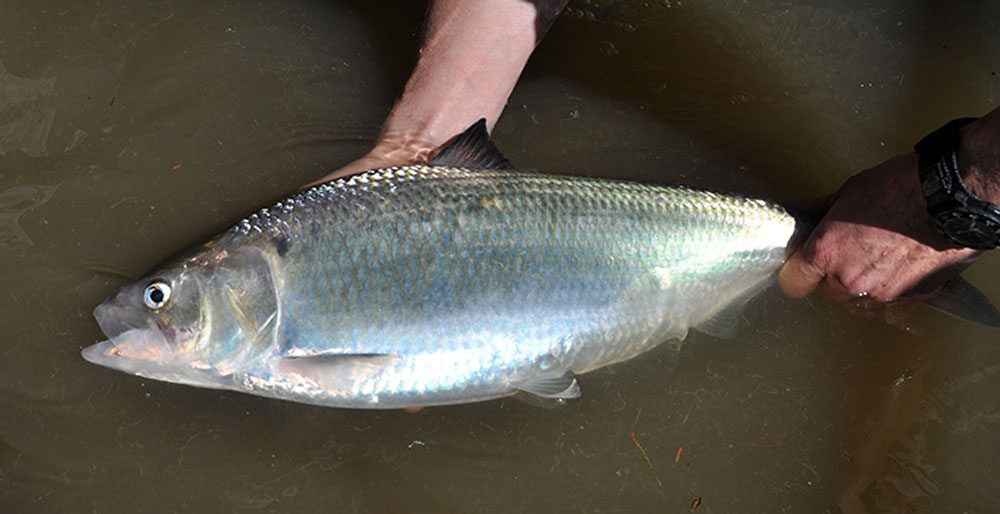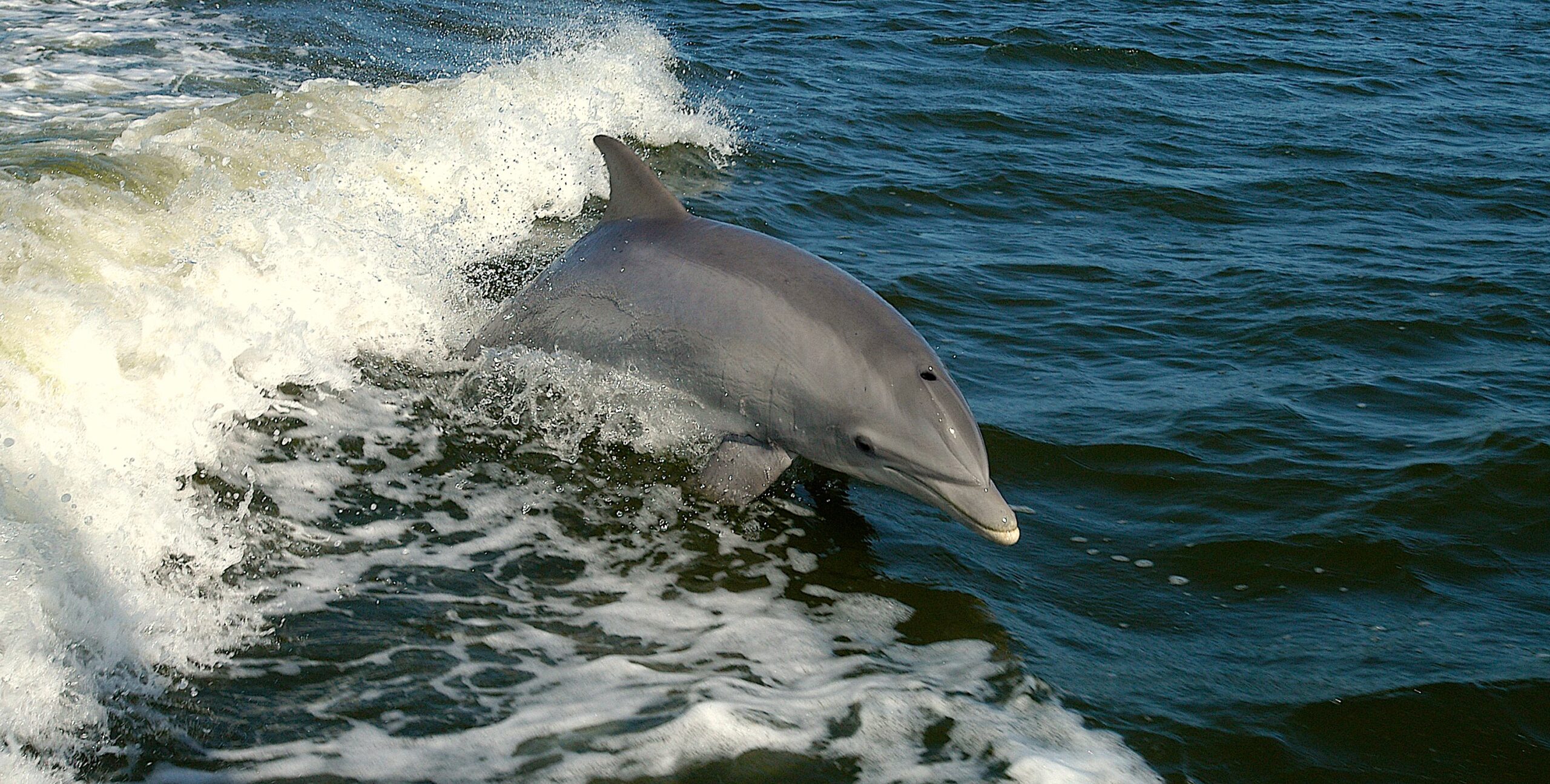GUTTING-EDGE SCIENCE: Fish Stomachs Help Identify Atlantic Pelagic Food Web
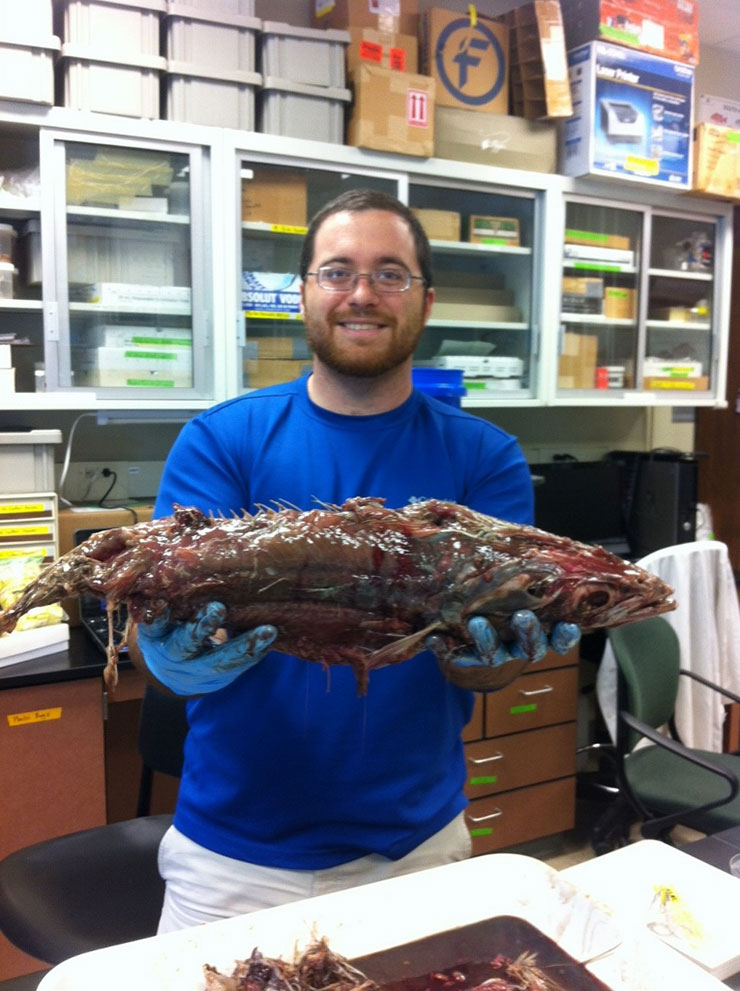
Catching fish is the most important part of fishing. Gutting is a messy step to cook what is landed. For seafood lovers and anglers, fish guts and gonads are rarely of any value. Most often, they land in the trash.
But Stephen Poland, a marine biology master’s student at the University of North Carolina Wilmington, has spent many months collecting the cast-offs from large pelagic fish — such as wahoo, tuna, mahimahi and marlin — caught in the Atlantic Ocean off the coasts of North and South Carolina. Pelagic fish live far off in the sea and travel widely rather than stay close to land.
“It is not something one should talk about right before dinner,” Poland admits. However, he adds that removing stomachs and studying their contents gives researchers the best chance of understanding predator-prey relationships among these fish.
Poland and his graduate advisor, Frederick Scharf, who teaches biology and marine biology at UNCW, say these discarded fish guts hold the key to understanding the complex ecological relationships between large Atlantic pelagic predators and their prey.
“There is not a lot known about the prey species that large pelagic fish are dependent upon and their basic life history even though we know they are central to the Atlantic marine ecosystem,” Scharf says.
Funded by North Carolina Sea Grant, Scharf and Poland are analyzing the stomach contents of these fish to answer half-understood questions such as: What do the predator fish eat? How much of it do they eat? How do their diets change throughout the year? How does it influence their reproductive output?
The project depends heavily on the catch from commercial and recreational fishermen and charter boats. This is an example of successful citizen science research, where fishermen collect the samples that researchers then analyze.
“The research has the potential to open doors for many other research endeavors. It will help answer a lot of questions and generate many others,” Poland says. The scientists hope that these findings and the resulting database will help create an ecological map and a comprehensive food web of the pelagic environment in the South Atlantic.
“Without such data and a bigger ecological map, it would be difficult to identify and avoid any future conflicts or tradeoffs in fisheries management,” Scharf adds. For example, he notes that it is hard to know how actions, such as fishing and harvesting a stock, might affect the fish population in the sea and alter the ecological balance of the Atlantic.
PREDATORS DO SAMPLING
Researchers know that top pelagic predators are capable of affecting community dynamics in offshore marine ecosystems. However, “sampling the species that large pelagic fish feed on has been traditionally difficult,” Scharf says.
Most of the prey often are not targeted by fisheries operating in the region, so sampling of these fishes is restricted to their occurrence in the diets of fish that are caught, Poland explains.
Stomach contents of predatory fish caught by commercial and recreational fishermen provide a viable and credible way of throwing light on the gaps in the Atlantic food web. This is why Poland spends most of his time collecting and analyzing fish innards.
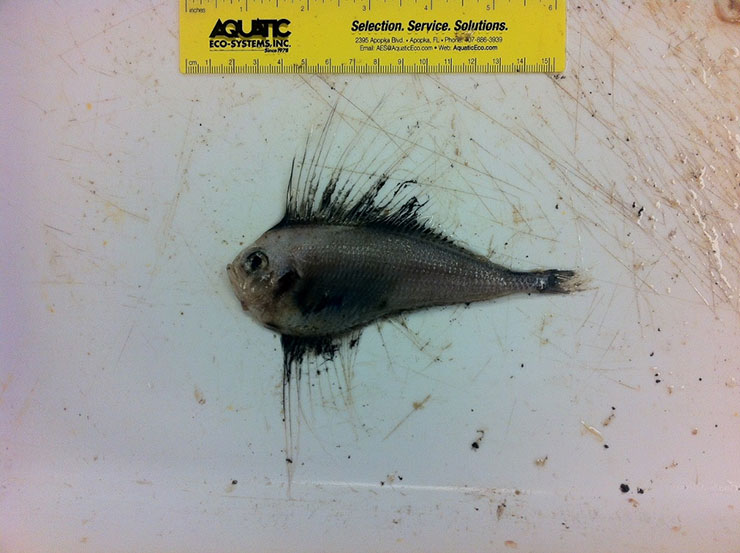
“This is the best way to collect this data. Right now, honestly, there is no other alternative,” says Scott Baker, North Carolina Sea Grant fisheries specialist.
In a related project, also funded by Sea Grant, Michelle Staudinger, formerly with UNCW and now with the University of Massachusetts, had shown that using large pelagic fish as biological samplers can show the role that cephalopods, such as squids and octopuses, play in the Atlantic food web.
Cephalopods, such as many other prey of Atlantic pelagic fish, are difficult to sample using standard survey gear, such as trawls and fish nets. However, large pelagic predators consume a great diversity of species, cephalopods included.
Staudinger’s research emphasized the value of using predators as biological samplers to gain insight into the geographical distribution of cephalopods. The method has the potential to track ecosystem changes in the region.
This knowledge is in line with a current shift toward ecosystem-based fisheries management.
“The need for fisheries management to move from individual species to a broader ecological focus is a stated federal government concern. There is an increasing awareness that we need to know how major action on single species might trigger effects and affect the entire food chain,” adds Baker, who spends some of his time working on reef fish issues with the South Atlantic Fishery Management Council.
Traditionally, fisheries management and regulatory policies were formed while considering every fish species in isolation without taking into account its complex interactions with other species. However, regulatory agencies and fisheries management experts increasingly are realizing that they need to develop a comprehensive understanding of the entire food web. With this knowledge, fisheries managers can determine how actions that affect one fish species, such as decisions to harvest them or regulate their catch, might alter the population of other species, leading to a chain of unanticipated changes in fish populations over time.
Scharf and Poland are meticulously collecting and studying fish guts to answer multiple research questions related to trophic level, or the position of these species, in the food web. They also are seeking more information on changes in their feeding patterns caused by ontogenetic — that is, reproduction and growth — and seasonal changes.
“For North and South Carolina, this would be the most extensive data yet that will focus on the predator-prey relationships in the pelagic ecosystem,” Scharf adds.
CITIZENS DOING SCIENCE
The foot soldier of the research, Poland gets most of his samples from offshore fishing tournaments held in North and South Carolina. The majority come from the 13 Governor’s Cup fishing tournaments organized by the respective state departments of marine fisheries. He also gets samples from other tournaments that are organized primarily during the peak spring and summer fishing season.
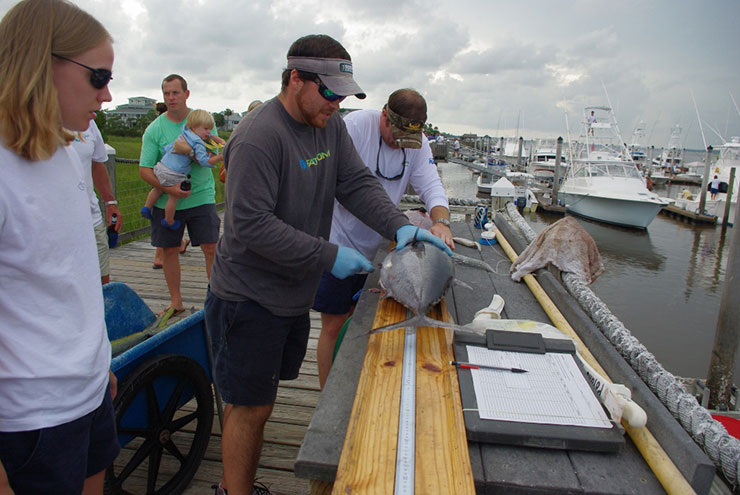
Recreational anglers are essential to this study. “The fishermen are really helpful and eager to provide samples,” Poland acknowledges. “Most of them are aware of the importance of marine conservation and are into fisheries management. They realize the importance of the research and know they can benefit by participating.”
During winter, Poland turns to charter boats, such as those that ply the Oregon Inlet in the Outer Banks. He also keeps in touch with other fishing fleets around the coast.
“For the lean season, I depend on these fishermen. I have built relationships with them and they have been very gracious to me,” Poland says. Typically, he meets them at the dock to sample their fish, or he gives them supplies to collect the stomachs and tissue samples as they clean their catch.
The fishermen help the researchers record the length, weight, sex and capture information. The researchers also remove stomachs, and samples of dorsal muscle and liver tissue from each fish and freeze them.
“The fishermen help us a lot,” Scharf says. After filleting the fish, the anglers store the carcasses on ice, ready for Poland to collect.
With the help of fishermen, Poland has been able to obtain diet data for more than 477 mahimahi, 238 wahoo, 287 blackfin tuna and 258 yellowfin tuna. He also has been able to gather samples of other species, such as bluefin tuna and blue marlin.
Collecting fish samples is half the task. The rest of it is done in the lab. First, stomach contents are removed and identified. Skeleton parts from the prey are used to help identification and to estimate its original size. After that, individual prey are counted, weighed and measured.
To map the food web in further detail, Scharf and Poland conduct stable isotope analyses, a popular method used to understand aquatic ecosystems. The process helps to highlight the primary producers that form the bases of food webs and explains the position of each species in the food web relative to each other.
All this will help fisheries managers and policy makers to become more adept at predicting the impact of their decisions on the food chain of Atlantic fish.
“Right now, we assume a lot of things about the fish population. We make a lot of our stock assessments and fish management decisions assuming that the population of a certain fish is fine,” says Randy Gregory, fisheries biologist with the N.C. Division of Marine Fisheries, adding that species interdependencies typically are not considered.
“If the supply of a certain prey fish stopped because of our actions, will there be something else to replace that prey fish? This data can help us make more informed decisions,” he continues.
CREATING THE WEB
Diving into the guts of fish for the past two years has resulted in observations that could affect the way big pelagic fish and their prey are harvested. For example, the UNCW researchers found that there was a high level of overlap between the diets of most predators, although the extent of overlap varied considerably.
“What we have been able to flesh out are some of the specific relationships between some of the fish and their prey,” Scharf says.
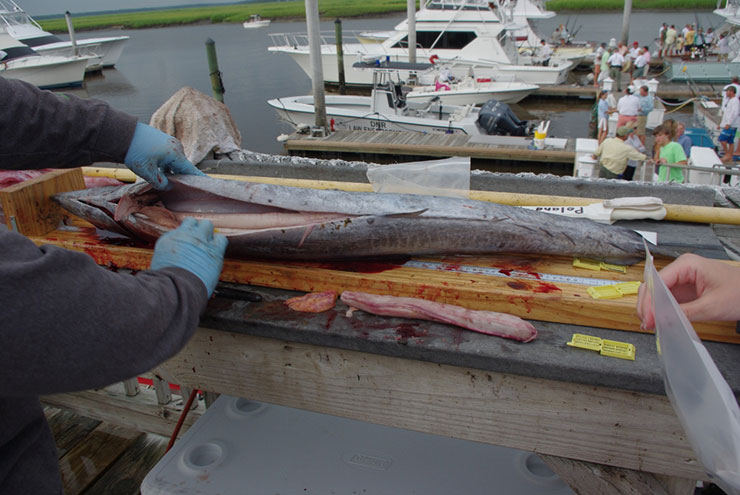
Stomach contents validated traditional wisdom that big fish eat small fish. Bullet tuna, or Auxis spp., were the single most important fish prey by both mass and number for yellowfin tuna, wahoo and blue marlin. They occurred in the diets of all predators except blackfin tuna.
Amphipods or squids, primarily shortfin squid, were the second-most favored choice of most predators, particularly for yellowfin and blackfin tuna.
“We see that most of the predators forage in similar habitats and rely on a few dominant prey items,” Scharf says.
Due to its abundance in the South Atlantic, he adds, bullet tuna is likely to be the primary prey for fish in the upper levels of the water column of the region.
Blackfin tuna has the most interesting diet pattern. Much more so than the other predators in the study, blackfin forages below the thermocline, a region of drastic temperature change that divides the surface water from the deep water. This behavior gives it the most diverse range of prey to feed from.
“We are almost at the last leg of the data collection and I will then start using the data to create the ecological model,” Poland says. The work is part of Poland’s master’s thesis that he will defend in 2014.
The work, Scharf says, can then be repeated in other parts of the East Coast. It can provide vital information for modeling population responses when considering the harvest of pelagic predators and making other regulatory policy decisions.
“Increased harvest of pelagic predators off of the U.S. Southeast coast could influence the food web in the offshore community and affect other commercially important fish populations,” Poland notes. The research will provide insight on the structure of the pelagic community that would inform and prevent unexpected effects on fish populations.
“This data will be useful for anybody who is doing something that can affect fish populations, particularly for those who are making decisions, like harvesting fish or deciding on fishing regulations. This data will have wide-ranging uses,” Gregory predicts.
This article was published in the Holiday 2013 issue of Coastwatch.
For contact information and reprint requests, visit ncseagrant.ncsu.edu/coastwatch/contact/.
- Categories:

